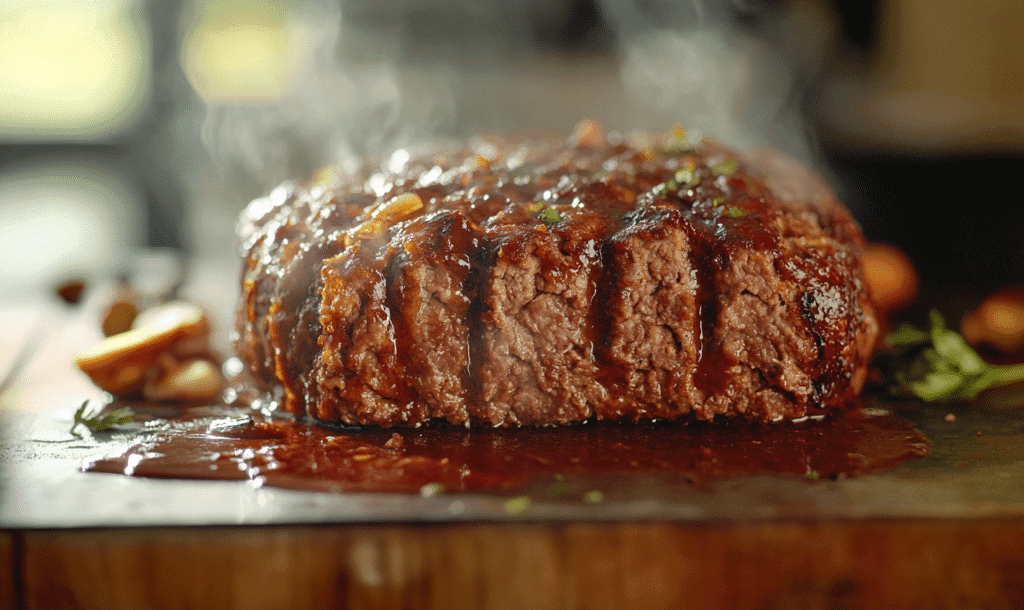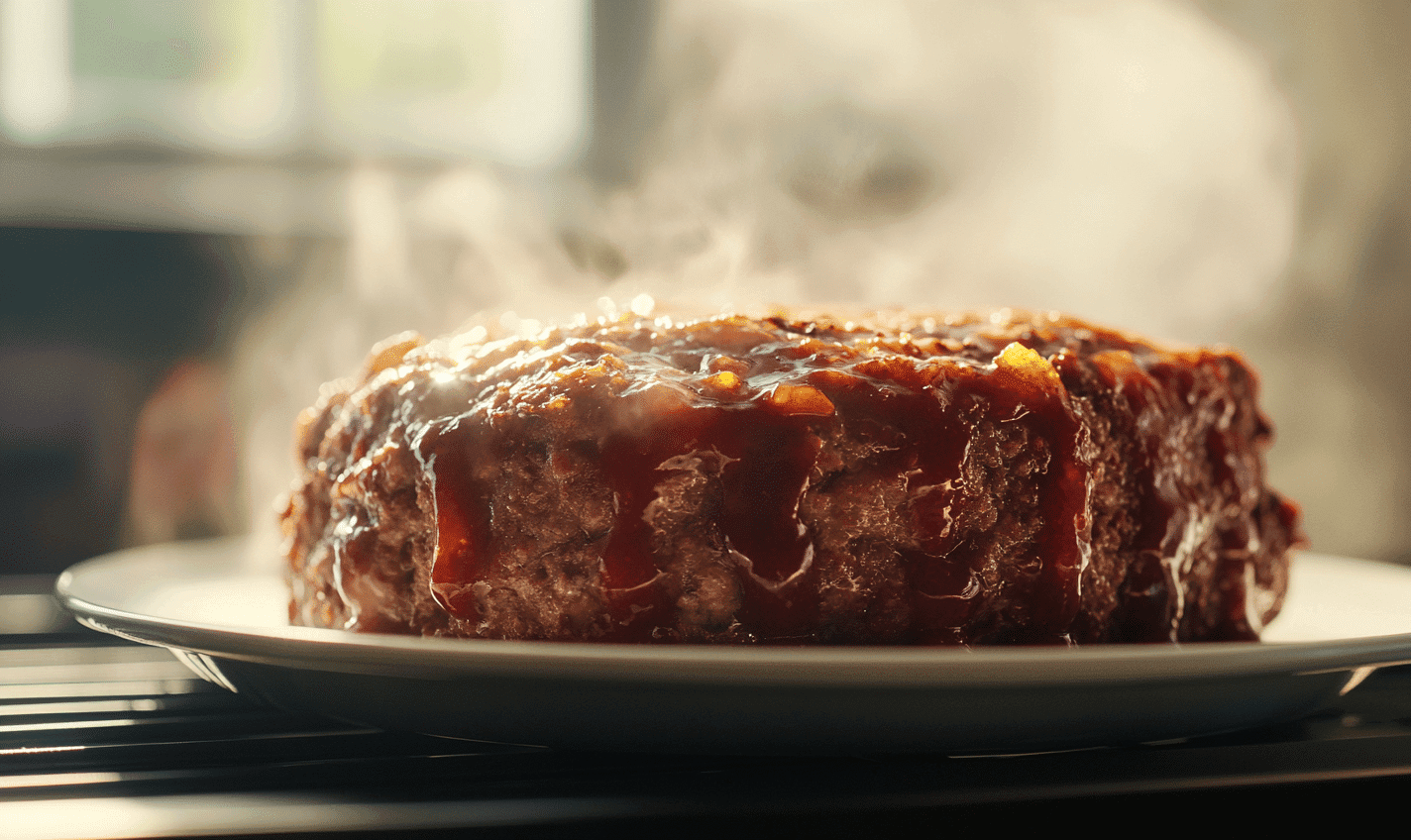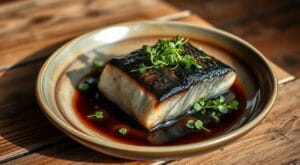Jump to:
Estimated reading time: 13 minutes
Table of contents
Introduction: Cook meatloaf covered or uncovered
Meatloaf is a timeless dish, beloved by many for its hearty flavor, ease of preparation, and the comfort it brings to the dinner table. Whether you’re a seasoned cook or a kitchen novice, one question inevitably arises when preparing this classic dish: Is it better to cook meatloaf covered or uncovered? This seemingly simple question can have a significant impact on the final outcome of your meatloaf, affecting everything from texture to flavor.
In this comprehensive guide, we’ll delve into the debate over whether to cook meatloaf covered or uncovered. We’ll explore the benefits and drawbacks of each method, the science behind how meatloaf cooks, and provide practical tips to help you decide which approach is best for your needs. By the end of this article, you’ll have a clear understanding of whether to cook meatloaf covered or uncovered, ensuring that your next meatloaf is a success.
Understanding the Basics: What Does It Mean to Cook Meatloaf Covered or Uncovered?
Cooking Meatloaf Covered
When you cook meatloaf covered, it means that you place a lid or cover (such as aluminum foil) over the meatloaf during the baking process. This method traps moisture and heat within the dish, creating a steamy environment that can affect the meatloaf’s texture and flavor.
Cooking Meatloaf Uncovered
On the other hand, when you cook meatloaf uncovered, the meatloaf is baked without any covering. This method exposes the surface of the meatloaf directly to the heat of the oven, which can result in a different texture and flavor compared to the covered method.
The Case for Cooking Meatloaf Covered
Cooking meatloaf covered offers several distinct benefits, particularly for those who prefer a moist, tender loaf. Let’s take a closer look at why some cooks swear by this method.
Cook meatloaf covered or uncovered: 1. Retaining Moisture
One of the primary reasons to cook meatloaf covered is to retain moisture. Covering the meatloaf with foil or a lid traps steam, which prevents the meat from drying out during the cooking process. This is particularly important if you’re using leaner meats like ground turkey or chicken, which have a lower fat content and are more prone to drying out. For more insights on keeping meatloaf moist.
Cook meatloaf covered or uncovered: 2. Even Cooking
When you cook meatloaf covered, the heat distribution is more even. The cover helps to regulate the temperature, ensuring that the meatloaf cooks uniformly from the inside out. This can be especially beneficial for larger loaves, where uneven cooking can result in a dry exterior and an undercooked center.
Cook meatloaf covered or uncovered: 3. Preventing the Glaze from Burning
Many meatloaf recipes call for a glaze made from ingredients like ketchup, brown sugar, or mustard. While this glaze adds flavor and a beautiful finish to the meatloaf, it can burn if exposed to direct heat for too long. By covering the meatloaf, you protect the glaze from burning, allowing it to cook gently and develop its flavors without charring.
Cook meatloaf covered or uncovered: 4. Enhanced Flavor Infusion
Covering the meatloaf also helps to infuse the flavors more deeply into the meat. The trapped steam circulates within the dish, allowing the seasonings, herbs, and spices to permeate the meat more effectively. This can result in a more flavorful meatloaf, as the ingredients have more time to meld together.
Cook meatloaf covered or uncovered: 5. Ideal for Slow Cooking
If you prefer a slow-cooked meatloaf that develops rich, deep flavors over time, cooking it covered is the way to go. The gentle, moist heat allows the meat to cook slowly, resulting in a tender, melt-in-your-mouth texture that is hard to achieve with faster cooking methods.
The Drawbacks of Cooking Meatloaf Covered
While there are several advantages to cooking meatloaf covered, this method also has its downsides. It’s important to weigh these drawbacks against the benefits when deciding whether to cook meatloaf covered or uncovered.
1. Lack of Crust
One of the most significant drawbacks of cooking meatloaf covered is the lack of a crispy crust. The steam generated by the cover keeps the surface of the meatloaf moist, which prevents it from developing the characteristic crust that many people love. If you enjoy a crispy, caramelized exterior on your meatloaf, cooking it covered might not be the best option.
2. Longer Cooking Time
Cooking meatloaf covered can result in a longer cooking time. The cover creates a moist environment that slows down the evaporation of liquids, which can extend the overall cooking process. If you’re short on time, you may find this method less convenient.
3. Potential for Overcooking
While covering meatloaf helps retain moisture, it can also increase the risk of overcooking if not monitored carefully. The steam trapped inside can continue to cook the meatloaf even after it’s removed from the oven, leading to a texture that’s too soft or even mushy.
4. Less Browning
Browning is a key component of flavor development in many meat dishes, including meatloaf. When you cook meatloaf covered, the surface of the meatloaf may not brown as much as it would if cooked uncovered. This can result in a less visually appealing dish and may also impact the depth of flavor.
The Case for Cooking Meatloaf Uncovered
Now that we’ve explored the benefits and drawbacks of cooking meatloaf covered, let’s turn our attention to the uncovered method. Cooking meatloaf uncovered offers its own set of advantages, especially for those who prioritize texture and flavor.
1. Crispy, Caramelized Crust
One of the most compelling reasons to cook meatloaf uncovered is the development of a crispy, caramelized crust. Without a cover, the surface of the meatloaf is exposed to the direct heat of the oven, allowing it to brown and crisp up beautifully. This crust adds texture and flavor, providing a satisfying contrast to the tender interior. For more tips on achieving the perfect crust, see this guide.
2. Shorter Cooking Time
When you cook meatloaf uncovered, the absence of a cover allows moisture to evaporate more quickly. This can result in a shorter cooking time compared to the covered method. If you’re looking for a quicker way to prepare meatloaf, cooking it uncovered might be the more efficient option. This article on The Daily Meal offers additional tips on optimizing your cooking time.
3. Better Browning and Maillard Reaction
Browning occurs more readily when meat is cooked uncovered. The Maillard reaction, a chemical process that occurs when proteins and sugars in the meat are exposed to heat, is responsible for the rich, savory flavors and golden-brown color on the surface of the meatloaf. Cooking meatloaf uncovered allows this reaction to take place more effectively, enhancing the overall flavor of the dish.
4. Visual Appeal
The visual appeal of a well-browned meatloaf cannot be underestimated. Cooking meatloaf uncovered allows it to develop a rich, golden-brown exterior that is not only appetizing but also indicative of a well-cooked dish. This can make a significant difference when serving meatloaf to guests or for special occasions. For more insights, check out these meatloaf tips.
5. More Control Over Texture
Cooking meatloaf uncovered gives you more control over the final texture. You can monitor the browning process and adjust the cooking time accordingly to achieve the desired level of crispiness. This flexibility is particularly valuable if you prefer a meatloaf with a specific texture or if you’re experimenting with different recipes.
The Drawbacks of Cooking Meatloaf Uncovered
While cooking meatloaf uncovered has its advantages, there are also some potential downsides to consider. Let’s take a look at the challenges associated with this method.
1. Risk of Dryness
One of the most significant risks when you cook meatloaf uncovered is dryness. Without a cover to trap moisture, the meatloaf is more exposed to the oven’s heat, which can cause it to dry out, especially if overcooked. This is a particular concern for leaner meatloaf recipes, where the lack of fat can exacerbate the issue. To learn more about maintaining moisture, see this article.
2. Uneven Cooking
Cooking meatloaf uncovered can sometimes result in uneven cooking, particularly in larger loaves. The exterior may cook faster than the interior, leading to a meatloaf that is overcooked on the outside and undercooked in the center. This can be especially problematic if you’re working with a thicker loaf.
3. Potential for Burning the Glaze
As mentioned earlier, many meatloaf recipes include a glaze that is applied during the final stages of cooking. When you cook meatloaf uncovered, the glaze is more exposed to the oven’s heat, which increases the risk of burning. This can result in a bitter, charred flavor that detracts from the overall dish.
4. Faster Evaporation of Liquids
When you cook meatloaf uncovered, the liquids within the meatloaf can evaporate more quickly. This can lead to a drier, less moist loaf if not carefully monitored. While some evaporation is desirable for achieving a crispy crust, too much can negatively impact the meatloaf’s texture.

Combining Both Methods: The Best of Both Worlds
Given the advantages and disadvantages of both cooking methods, you might wonder if it’s possible to combine them to get the best of both worlds. The answer is yes! In fact, many experienced cooks recommend starting the meatloaf covered and finishing it uncovered to achieve the ideal balance of moisture and browning.
1. Start Covered, Finish Uncovered
One effective technique is to begin the cooking process with the meatloaf covered. This helps retain moisture and ensures even cooking during the initial stages. About 15-20 minutes before the meatloaf is done, remove the cover to allow the exterior to brown and develop a crispy crust. This approach provides the benefits of both methods without the drawbacks. More on this technique can be found here.
2. Use a Foil Tent
Another variation of this method involves creating a “foil tent” over the meatloaf. Rather than wrapping the meatloaf tightly in foil, loosely cover it with a piece of foil that allows some steam to escape. This method retains moisture while still allowing the surface to brown gradually. You can remove the tent during the final cooking stages for additional browning.
3. Adjust the Oven Temperature
If you choose to start the meatloaf covered and finish it uncovered, consider adjusting the oven temperature. You might begin at a lower temperature, such as 325°F (165°C), to gently cook the meatloaf while covered. Then, increase the temperature to 375°F (190°C) when you remove the cover to promote browning. This approach provides more control over the cooking process and helps prevent overcooking.
Practical Tips for Perfect Meatloaf Every Time
Whether you decide to cook meatloaf covered or uncovered, there are a few additional tips that can help you achieve the best results.
1. Use a Meat Thermometer
Regardless of the cooking method, using a meat thermometer is crucial for ensuring that your meatloaf is cooked to the right internal temperature. Insert the thermometer into the thickest part of the meatloaf, making sure it reaches 160°F (71°C) before removing it from the oven. This ensures that your meatloaf is safe to eat and perfectly cooked.
2. Rest the Meatloaf
After cooking, let the meatloaf rest for 10-15 minutes before slicing. This resting period allows the juices to redistribute throughout the meat, resulting in a juicier and more flavorful loaf. Whether you cook it covered or uncovered, this step is essential for the best texture.
3. Customize the Glaze
Experiment with different glaze recipes to find one that complements your preferred cooking method. If you cook the meatloaf uncovered, consider using a glaze with a higher sugar content that can caramelize without burning. If you cook it covered, opt for a glaze with bold flavors that will infuse into the meat during cooking.
4. Monitor the Cooking Time
Whether you cook meatloaf covered or uncovered, it’s important to monitor the cooking time closely. Check the internal temperature regularly, especially if you adjust the oven temperature or use a combination of methods. This attention to detail can help you avoid overcooking or undercooking your meatloaf.
5. Consider the Meat Mixture
The type of ground meat you use in your meatloaf can affect the outcome. A mix of ground beef, pork, and veal (sometimes called a meatloaf mix) offers a good balance of flavor and fat, which can help keep the meatloaf moist regardless of the cooking method. If using leaner meats, add moisture-rich ingredients like onions, bell peppers, or breadcrumbs soaked in milk to prevent dryness.
Frequently Asked Questions: Cook meatloaf covered or uncovered
Should I cook meatloaf covered or uncovered?
Meatloaf is typically cooked uncovered to allow the edges to brown and develop a crust. This crust adds flavor and texture. Cooking uncovered also helps excess moisture evaporate, so the meatloaf isn’t too soggy.
When should I cover meatloaf while baking?
If you’re concerned about the meatloaf drying out, you can cover it for the first 15-20 minutes to lock in moisture, then uncover it for the rest of the cooking time. This can be helpful if using lean meat or if the meatloaf is browning too quickly.
Does covering meatloaf affect cooking time?
Yes, covering meatloaf can slightly speed up cooking, as it traps heat and moisture inside the pan. If you cover the meatloaf, keep an eye on the internal temperature and be ready to uncover it for the last 10-15 minutes to help develop a flavorful crust.
Should I cover meatloaf when adding a glaze?
To prevent the glaze from becoming too sticky or watery, it’s best to add the glaze after uncovering the meatloaf. Brush on the glaze in the last 15 minutes of baking, uncovered, so it has time to caramelize without getting too runny.
Conclusion: Cook meatloaf covered or uncovered
So, is it better to cook meatloaf covered or uncovered? The answer ultimately depends on your personal preferences and the specific outcome you’re aiming for.
If you prioritize a moist, tender meatloaf with even cooking, then cooking it covered may be the better option. On the other hand, if you prefer a meatloaf with a crispy, caramelized crust and a more intense flavor, cooking it uncovered might be the way to go. For those who want the best of both worlds, a combination approach—starting covered and finishing uncovered—offers a balanced solution.
Regardless of the method you choose, the key to a perfect meatloaf lies in careful monitoring, using a meat thermometer, and adjusting the cooking process as needed. By understanding the pros and cons of cooking meatloaf covered or uncovered, you can make an informed decision that suits your taste and ensures a delicious result every time.
So the next time you prepare meatloaf, you’ll know exactly whether to cook it covered or uncovered to achieve the perfect dish. Happy cooking!






